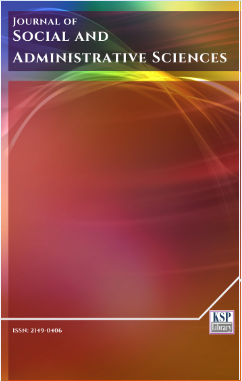Doctor-patient mutual trust, telemedicine quality, and satisfaction: The role of knowledge management
Abstract
Abstract. Distant medical care satisfaction demands high quality care result. Both quality and satisfaction rely heavily on collective operations on knowledge of and relations between patients and doctors. Thus, knowledge sharing and doctor-patient trust are among the two critical factors that may lead to medical care quality and satisfaction. However, existing literature discussed the abovementioned in a scant fashion and without considering the gap between knowledge of owners in this context (i.e., care offerers such as doctors and receivers like patients). This paper proposes a conceptual model for an integrative discussion of the relationships among knowledge sharing, trust, medical care quality and patient satisfaction, from a fresh perspective of knowledge gap. Theoretical and practical implications are expected to be rich because this conceotual piece offer discussions from a viewpoint that starts from the mnost fundamental factor – collective knowledge attribute in terms of its heterogeneous structure.
Keywords. Knowledge sharing, Trust, Distant medical care, Quality, Satisfaction.
JEL. D80, D83, D84, D85.Keywords
References
Alavi, M. & Leidner, D.E. (1999). Knowledge management systems: Issues, challenges and benefits, Communication of the AIS, 1(7), 1-37.
Anderson, L.A., & Dedrick, R.F. (1990). Development of the trust in physician scale: A measure to assess interpersonal trust in patient-physician relationships. Psychological Reports, 67(3), 1091-100. doi. 10.2466/pr0.1990.67.3f.1091
Bukowitz, R., & Williams, L. (1999). The Knowledge Management Field Book. London: Pearson.
Choi et al., (2004). The relationships among quality, value, satisfaction and behavioral intention in health care provider choice: A South Korean study. Journal of Business Research, 57(8), 913-921. doi. 10.1016/S0148-2963(02)00293-X
Deutsch, M. (1958). Trust and suspicion, Journal of Conflict Resolution, 2(4), 265-279. doi. 10.1177/002200275800200401
Donabedian, A. (1988). The quality of care: How can it be assessed?. Journal of the American Medical Association, 260, 1743–1748.
Dugan, E., Trachtenberg, F.L., & Hall, M. (2005). Development of abbreviated measures to assess patient trust in a physician, a health insurer, and the medical profession. BMC Health Services Research, 5(1), 64 doi. 10.1186/1472-6963-5-64
Earl, M.J. (2001). Knowledge management strategies: Toward a taxonomy. Journal of Management Information Systems, 18(1), 215-242. doi. 10.1080/07421222.2001.11045670
Hall, B.H., Jaffe, A., & Trajtenberg, M. (2001). The NBER patent citations data file: Lessons, insights and methodological tools. NBER Working Papers, No.8498. doi. 10.3386/w8498
Hendriks, P. (1999). Why share knowledge? The influence of ICT on the motivation for knowledge sharing. Knowledge and Process Management, 6(2), 91-100. doi. 10.1002/(SICI)1099-1441(199906)6:2<91::AID-KPM54>3.0.CO;2-M
Kramer, R.M., & Tyler, T.R. (1996). Trust in Organizations: Frontiers of Theory and Research. Thousand Oaks. Sage Publications.
Lee, S.M., & Hong, S. (2002). An enterprise-wide knowledge management system infrastructure, lndustrial Management and Data Systems, 102(1), 17-25. doi. 10.1108/02635570210414622
Lichtenstein, S., & Hunter, A. (2005). Receiver Influences on Knowledge Sharing. 13th European Conference on Information Systems, Information Systems in a Rapidly Changing Economy, ECIS 2005, Regensburg, Germany, May 26-28.
Ranaweera, C., & Prabhu, J. (2003). The influence of satisfaction, trust and switching barriers on customer retention in a continuous purchasing setting. International Journal of Service Industry Management, 14(4), 374-395. doi. 10.1108/09564230310489231
Rolland, N., & Chauvel, D. (2000). Knowledge transfer in strategic alliances, In C. Despres, & D. Chauvel, (Eds.), Knowledge Horizons: The Present and the Promise of Knowledge Management, Boston, M.A.: Butterworth Heinemann.
Roberts, J. (2000). From know-how to show-how? Questioning the role of information and communication technologies in knowledge transfer, Technology An'sis and Strategic Management, 12(4), 429-443. doi. 10.1080/713698499
Mayer, R.C., Davis, J.H. & Schoorman, F.D. (1995). An integrative model of organizational trust. The Academy of Management Review, 20(3), 709-734. doi. 10.2307/258792
Mechanic, D., & Meyer, S. (2000). Concepts of trust among patients with serious illness. Social Science & Medicine, 51(5), 657-668. doi. 10.1016/S0277-9536(00)00014-9
McAllister, D.J. (1995). Affect- and cognition-based trust formations for interpersonal cooperation in organizations. The Academy of Management Journal, 38(1), 24-59. doi. 10.2307/256727
Maxham III, J.G., & Netemeyer, R.G. (2002). Modeling customer perceptions of complaint handling over time: the effects of perceived justice on satisfaction and intent. Journal of Retailing, 78(4), 239-252. doi. 10.1016/S0022-4359(02)00100-8
Nancy, J.L. (2000). Being Singular Plural. Stanford California: Stanford University Press.
Pearson, S.D., & Raeke, L.H. (2000). Patients' trust in physicians: Many theories, few measures, and little data. Journal of General Internal Medicine, 15(7), 509-513. doi. 10.1046/j.1525-1497.2000.11002.x
Rotter, J.B. (1967). A new scale for the measurement of interpersonal trust. Journal of Personality, 35(4), 651-665. doi. 10.1111/j.1467-6494.1967.tb01454.x
Rotter, J.B. (1980). Interpersonal trust, trustworthiness, and gullibility. American Psychologist, 35(1), 1–7. doi. 10.1037/0003-066x.35.1.1
Sabel, C.F. (1993). Studied trust: Building new forms of cooperation in a volatile economy. Human Relations, 46(9), 1133-1170. doi. 10.1177/001872679304600907
Senge, P.M. (1997). The fifth discipline, Measuring Business Excellence. 1(3), 46-51. doi. 10.1108/eb025496
Sztompka, P. (1999). Thrust: A Sociological Theory. Cambridge University Press.
Thorn, B.E., Clements, K.L., Ward, L.C., Dixon, K.E., Kersh, B.C., Boothby, J.L., & Chaplin, W.F. (2004). Personality factors in the explanation of sex differences in pain catastrophizing and response to experimental pain. The Clinical Journal of Pain, 20(5), 275-82. doi. 10.1097/00002508-200409000-00001DOI: http://dx.doi.org/10.1453/jsas.v6i4.1990
Refbacks
- There are currently no refbacks.
....................................................................................................................................................................................................................................................................................................................................... Journal of Social and Administrative Sciences - J. Adm. Soc. Sci. - JSAS - www.kspjournals.org
ISSN: 2149-0406
Editor: editor-jsas@kspjournals.org Secretarial: secretarial@kspjournals.org Istanbul - Turkey.
Copyright © KSP Library




